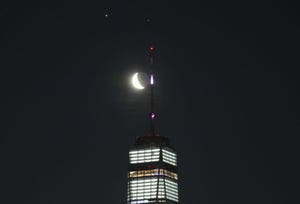How to See Mars and Jupiter Cuddle Up in the Sky in a Conjunction This Week

The next time these two planets will be this close together will be 2033.
This week has already given us an aurora borealis and the Perseids meteor shower. Wednesday morning is your next chance to see a spectacular sky event. Mars and Jupiter will be in conjunction, meaning basically on top of each other, making them fairly easy to view, even without a telescope.
The two planets will be one-third of a degree apart, which NASA notes “is less than the width of the full moon.” More accurately, the planets will be about 350 million miles apart, but their orbits are lining up in such a way that Mars looks like it’s about to collide with Jupiter.
Read more: Aurora Borealis Will Be Visible Again to the Northernmost US States
The two planets will be right next to each other, and it may be difficult to differentiate them at first. However, Mars will appear to be floating in front of and to the left of Jupiter. Of the two planets, Jupiter will be brighter, so you’ll likely spot it first and then have to look for Mars afterward.
The two planets hanging out this close together, which astronomers call a conjunction, will be visible in the night sky all over the US. In the eastern or northeastern sky depending on your location and what time you look. The two planets should rise in the night sky between 1:30 a.m. and 2:30 a.m. for most folks and will be tucked in the Taurus and Auriga constellations. Stargazers may be familiar with Auriga as the host constellation for the Alpha Aurigids meteor shower that’ll peak later this month.
When is the best time to view Mars and Jupiter?
The two planets should rise above the horizon a little after midnight in most parts of the US. They will continue to get higher in the sky until sunrise, when the light from the sun drowns them out. NASA says that the best time to view the two planets is a couple of hours before sunrise, as they will be nice and high in the sky. Of course, weather is a factor, and they will be harder to see in a larger city with too much light pollution.
Tuesday night into Wednesday morning is the night at which the two planets will be the closest together. After Wednesday morning, Mars will begin drifting away from Jupiter, but it takes time for that to happen. Thus, you should be able to see the two planets reasonably close together for a few days. After that, they’ll get farther and farther part over the coming weeks.
Read more: It’s Your Last Chance to Catch the Dazzling Perseids Meteor Shower
Do I need a telescope or binoculars?
Nope. The two planets will be plainly visible as long as there isn’t too much light pollution. However, since they are so close together, a telescope or binoculars may help you see them better. They will look as though they are functionally on top of one another, so once you see one of the planets, you technically see both of them, you just need to pick Mars out from the brighter Jupiter.
Read more: Once-in-a-Lifetime Cosmic Nova Explosion Is Coming: How to Watch
How rare is a Mars and Jupiter conjunction?
The two get together about once every couple of years. Mars and Jupiter have been in conjunction 11 times since 2000 and are on schedule to do it again in November 2026. It’s much rarer to see them this close together, though, which makes Wednesday morning’s viewing a special occasion for space fans. The next time they’ll be this close won’t be until 2033, when NASA says they’ll be even closer than they are this time around.


